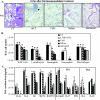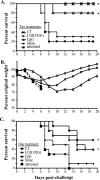Prophylactic administration of bacterially derived immunomodulators improves the outcome of influenza virus infection in a murine model
- PMID: 20053748
- PMCID: PMC2826051
- DOI: 10.1128/JVI.01805-09
Prophylactic administration of bacterially derived immunomodulators improves the outcome of influenza virus infection in a murine model
Abstract
Prophylactic or therapeutic immunomodulation is an antigen-independent strategy that induces nonspecific immune system activation, thereby enhancing host defense to disease. In this study, we investigated the effect of prophylactic immunomodulation on the outcome of influenza virus infection using three bacterially derived immune-enhancing agents known for promoting distinct immunological profiles. BALB/c mice were treated nasally with either cholera toxin (CT), a mutant form of the CT-related Escherichia coli heat-labile enterotoxin designated LT(R192G), or CpG oligodeoxynucleotide. Mice were subsequently challenged with a lethal dose of influenza A/PR/8/34 virus 24 h after the last immunomodulation treatment and either monitored for survival or sacrificed postchallenge for viral and immunological analysis. Treatment with the three immunomodulators prevented or delayed mortality and weight loss, but only CT and LT(R192G) significantly reduced initial lung viral loads as measured by plaque assay. Analysis performed 4 days postinfection indicated that prophylactic treatments with CT, LT(R192G), or CpG resulted in significantly increased numbers of CD4 T cells, B cells, and dendritic cells and altered costimulatory marker expression in the airways of infected mice, coinciding with reduced expression of pulmonary chemokines and the appearance of inducible bronchus-associated lymphoid tissue-like structures in the lungs. Collectively, these results suggest that, despite different immunomodulatory mechanisms, CT, LT(R192G), and CpG induce an initial inflammatory process and enhance the immune response to primary influenza virus challenge while preventing potentially damaging chemokine expression. These studies provide insight into the immunological parameters and immune modulation strategies that have the potential to enhance the nonspecific host response to influenza virus infection.
Figures






Similar articles
-
Mucosal delivery of inactivated influenza vaccine induces B-cell-dependent heterosubtypic cross-protection against lethal influenza A H5N1 virus infection.J Virol. 2001 Jun;75(11):5141-50. doi: 10.1128/JVI.75.11.5141-5150.2001. J Virol. 2001. PMID: 11333895 Free PMC article.
-
The level of protection against rotavirus shedding in mice following immunization with a chimeric VP6 protein is dependent on the route and the coadministered adjuvant.Vaccine. 2002 Mar 15;20(13-14):1733-40. doi: 10.1016/s0264-410x(02)00043-9. Vaccine. 2002. PMID: 11906760
-
Immunostimulant patch containing heat-labile enterotoxin from Escherichia coli enhances immune responses to injected influenza virus vaccine through activation of skin dendritic cells.J Virol. 2003 May;77(9):5218-25. doi: 10.1128/jvi.77.9.5218-5225.2003. J Virol. 2003. PMID: 12692224 Free PMC article.
-
A proposal for safety standards for human use of cholera toxin (or Escherichia coli heat-labile enterotoxin) derivatives as an adjuvant of nasal inactivated influenza vaccine.Jpn J Infect Dis. 2000 Jun;53(3):98-106. Jpn J Infect Dis. 2000. PMID: 10957706 Review.
-
Importance of receptor binding in the immunogenicity, adjuvanticity and therapeutic properties of cholera toxin and Escherichia coli heat-labile enterotoxin.Med Microbiol Immunol. 1998 Jun;187(1):3-10. doi: 10.1007/s004300050068. Med Microbiol Immunol. 1998. PMID: 9749977 Review. No abstract available.
Cited by
-
Inflammation and Cognition in Children and Adolescents: A Call for Action.Front Pediatr. 2020 Sep 9;8:583. doi: 10.3389/fped.2020.00583. eCollection 2020. Front Pediatr. 2020. PMID: 33014950 Free PMC article. No abstract available.
-
Trained Immunity-Based Vaccines: A New Paradigm for the Development of Broad-Spectrum Anti-infectious Formulations.Front Immunol. 2018 Dec 17;9:2936. doi: 10.3389/fimmu.2018.02936. eCollection 2018. Front Immunol. 2018. PMID: 30619296 Free PMC article. Review.
-
A critical role of IL-17 in modulating the B-cell response during H5N1 influenza virus infection.Cell Mol Immunol. 2011 Nov;8(6):462-8. doi: 10.1038/cmi.2011.38. Epub 2011 Sep 26. Cell Mol Immunol. 2011. PMID: 21946434 Free PMC article.
-
Glucan supplementation enhances the immune response against an influenza challenge in mice.Ann Transl Med. 2015 Feb;3(2):22. doi: 10.3978/j.issn.2305-5839.2015.01.08. Ann Transl Med. 2015. PMID: 25738142 Free PMC article.
-
The Mucosal Vaccine Adjuvant LT(R192G/L211A) or dmLT.mSphere. 2018 Jul 25;3(4):e00215-18. doi: 10.1128/mSphere.00215-18. mSphere. 2018. PMID: 30045966 Free PMC article. Review.
References
-
- Anonymous. 2008. Influenza fact sheet no. 211. World Health Organization, Geneva, Switzerland.
-
- Bromander, A., J. Holmgren, and N. Lycke. 1991. Cholera toxin stimulates IL-1 production and enhances antigen presentation by macrophages in vitro. J. Immunol. 146:2908-2914. - PubMed
Publication types
MeSH terms
Substances
LinkOut - more resources
Full Text Sources
Other Literature Sources
Medical
Research Materials

